Making a delicious, crusty bread recipe from scratch often calls for baking in a Dutch oven. But what if you don't have one, or want to make extra loaves? No worries - we have you covered with these easy Dutch oven substitutes!
WATCH THE VIDEO: How to bake bread with no dutch oven
BREAD! One of our favorite topics.
If you've read through our easy crusty bread recipe, you know we're fans of baking no-knead bread in a preheated Dutch Oven in order to achieve a crispy, crackly crust and a soft interior.
But if you don't have a Dutch oven, or if you want to bake more than one loaf at a time, never fear! We're about to walk you through three of our favorite easy ways to bake crispy, crusty bread without any special equipment.
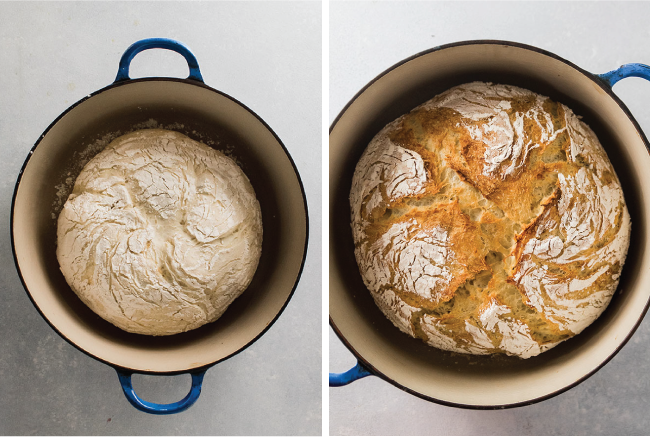
Why bake in Dutch Ovens, anyway?
A Dutch Oven conducts heat evenly for consistent baking, and has a heavy lid that traps any steam released by the bread while it cooks.
And the key to crusty homemade bread? STEAM. (But not too much!)
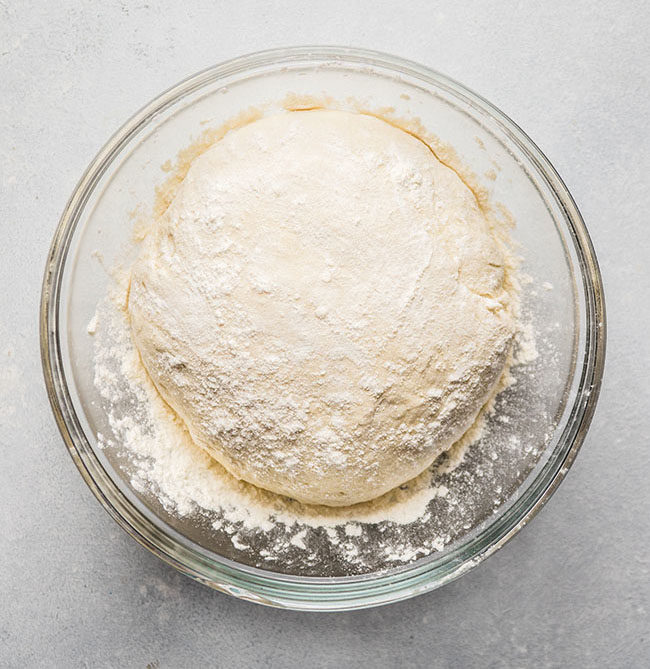
Why Steam Matters for Crusty Bread
Steam is useful because it keeps the outside of your loaf from setting before the bread rises, drying out, or baking too quickly (you don't want to burn your crust while you wait for the center of the bread to cook!)
By slowing down crust formation, steam helps the bread rise rapidly without the constraint of a stiff crust when it hits the oven (known as "oven spring"), keeps the outer crust thin and crispy rather than tough and chewy, and lets bread develop a deep brown color without burning. (PS - Want to know more about how steam works in bread baking? There's a great article here!)
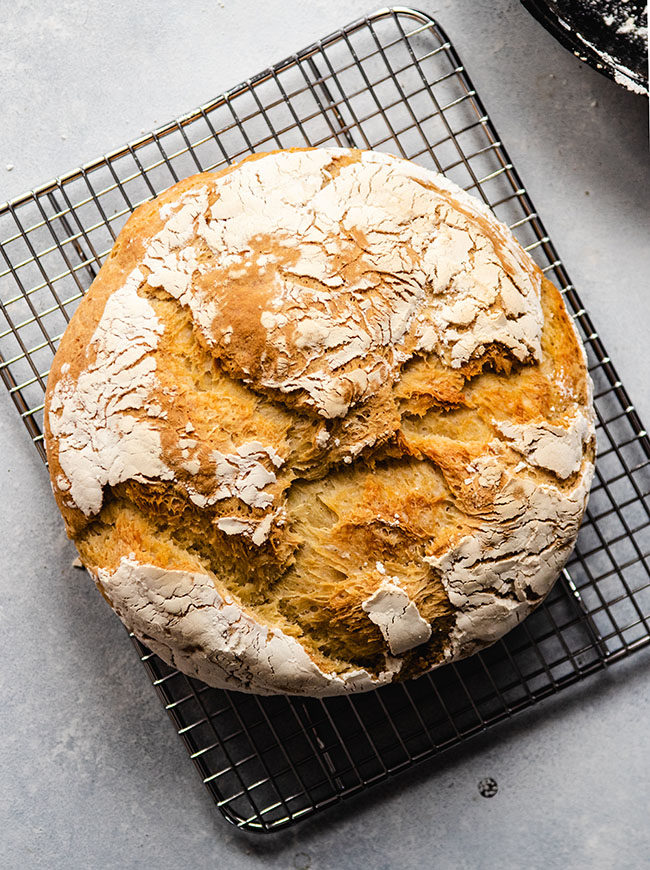
Professional bread ovens have steam injectors built right in. In a dutch oven covered with a lid, the bread essentially steams itself!
SO. When we talk about a Dutch oven alternative for bread, what we're really talking about is how to create steam inside your oven.
Steam is an important ingredient in crusty bread baking right up until the loaf has set and begun to brown. Once that happens, it's time to remove steam from the equation (too much steam can make your crust thick and tough!)
In our Easy Crusty Bread recipe, we accomplish this by removing the lid for the last 10-20 minutes of bake time. In the methods below, you'll either remove a lid, remove a dish of water, or control the amount of water you use so it evaporates in time to let the bread crisp up.
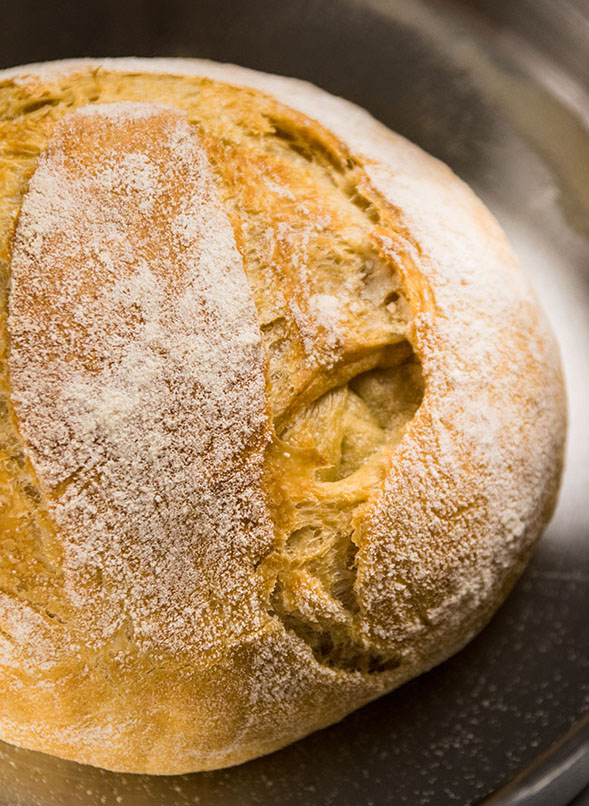
Alright. Let's look at a few substitutes to help you bake crusty bread without a Dutch Oven.
For reference, our favorite Easy Crusty French Bread recipe calls for baking bread in a Dutch oven at 460 degrees F for 30 minutes covered and an additional 10-20 minutes uncovered.
Please note: Do not substitute glass bakeware for any of the equipment discussed in this post as glass can shatter when exposed to extreme temperature changes. When using these techniques, please use the recommended equipment.
Option 1: A pair of cast iron skillets + Ice cubes
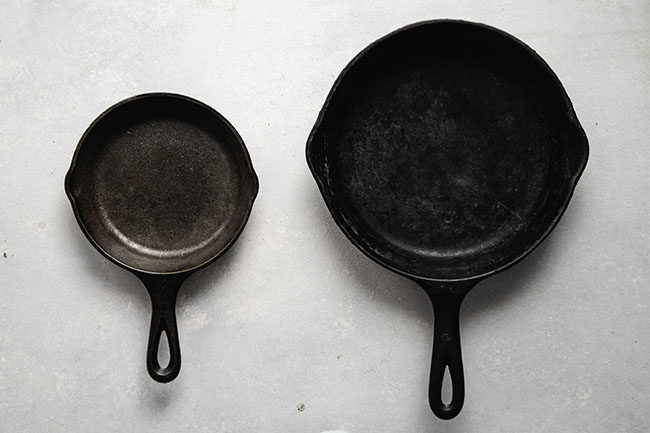
Preheat two cast iron skillets (we recommend one 8" to 12" skillet for the bread itself, and one 6" to 8" skillet to hold the ice cubes we'll use to create steam) in the oven while it heats before baking. Place the smaller skillet on a separate oven rack directly below the large skillet.
Note: If you're using a Dutch Oven Bread recipe like ours, the instructions will usually tell you to preheat the Dutch Oven. If you're using this method, just preheat the cast iron skillet instead!
When it's time to bake, grab 8-10 ice cubes from the freezer and have them ready to go (I like to put them in a small bowl for easy pouring later).
Use oven mitts to remove the large cast iron skillet from the oven. Gently set your bread down into the hot skillet (don't burn yourself!).
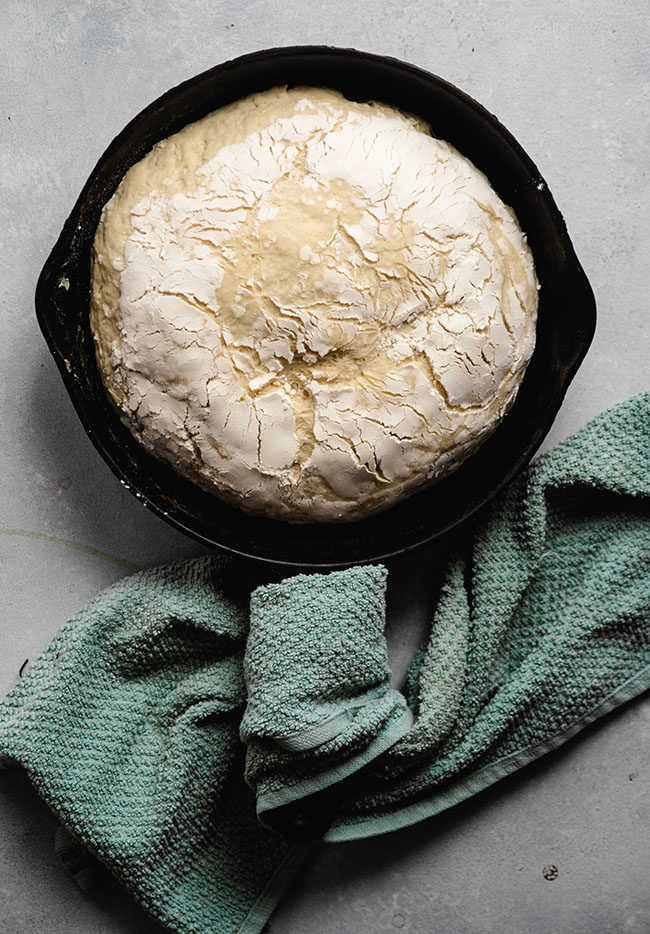
Put your oven mitts back on, then carefully place the hot skillet back into the oven.
As soon as the bread is in the oven, quickly (but carefully!) pour your ice cubes into the second hot skillet and close the oven door.
The ice will steam as it hits the hot pan, creating the steam you need for a crispy crust. The water from the ice cubes will completely evaporate after 20ish minutes, leaving your bread to finish baking in a steam-free oven for a perfect crispy crust.
Note: We do NOT recommend using this ice cube method with a glass or ceramic baking dish, as the extreme temperature difference can cause these materials to break.
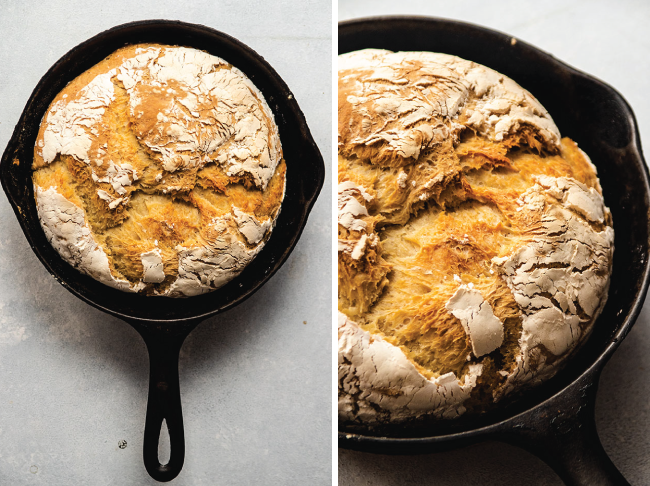
Option 2: Use an oven-safe pot and a tight lid or sheet pan
Next up: baking crusty bread with an oven-safe pot and a sheet pan! If your pot has a tight-fitting, oven-safe lid, feel free to use that instead of a sheet pan.
Note: I always opt for a sheet pan here because most of my pot lids have drainage holes for easy straining. Great for draining pasta, but not great at keeping steam trapped inside the pot.
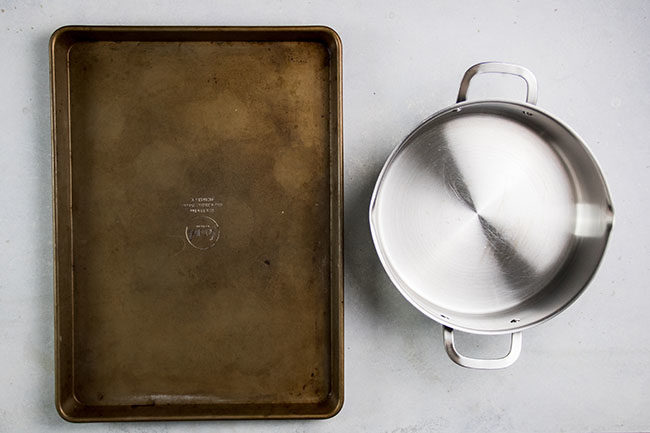
I recommend a stockpot instead of a regular baking dish because traditional casserole dishes are usually too short to successfully bake crusty bread in: the bread will either hit the baking sheet on top and flatten out into a sad blob, or it will rise so high that it lifts the cookie sheet up off the dish and lets out all the steam.
For best results, make sure you're using a pot or dish that's at least 4 inches deep in order to give the bread room to rise as it bakes. A 5 or 6 quart saucepan or stock pot will do a great job - just make sure it's oven-safe (like this one, which is safe up to 500 degrees F!)
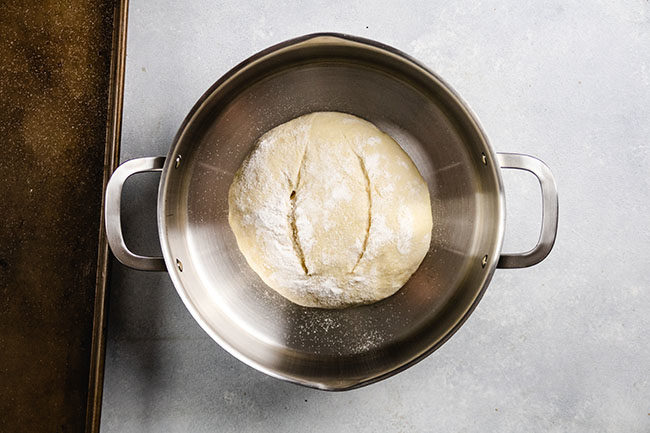
If you're using a regular stainless steel pot, you can skip the preheating-your-pan step here.
A steel pot like this will heat up much more quickly than a cast iron skillet or Dutch oven, and because it doesn't distribute heat as evenly it's more likely to burn the bottom of your bread if preheated.
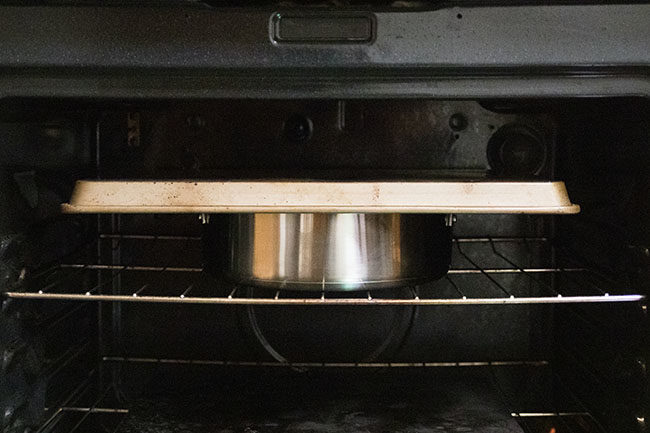
Instead, when you're ready to bake, place your formed loaf directly into the cold pot, then set in your hot oven and immediately cover with your baking sheet.
Bake as directed by your recipe, and remove the baking sheet during the last 10-20 minutes of baking just like you would a Dutch oven lid.
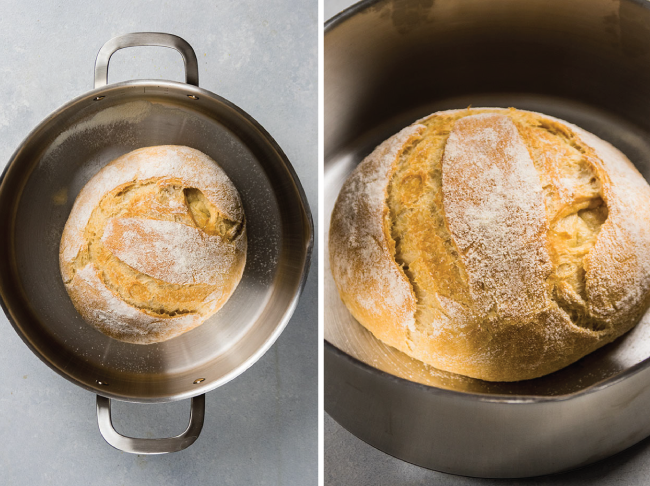
Option 3: Use a baking steel or pizza stone and a dish of water
Last, but definitely not least - bake your bread on a good ol' pizza stone or baking steel. (We love our baking steel!) and use a dish of water to create steam. Like Dutch ovens, a baking steel conducts heat well and distributes it evenly for a uniform bake.
For best results, preheat your baking steel for 45 minutes to 1 hour before baking.
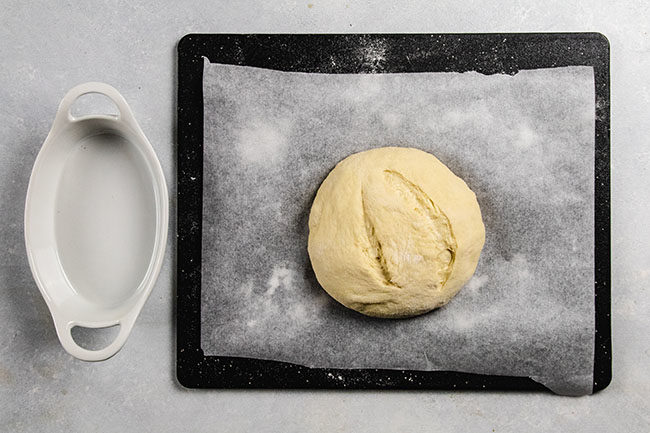
To create steam, fill a small baking dish with water (1 cup is usually plenty) and place it in the oven, on a rack directly under your baking stone or steel, 5-10 minutes before you place your bread in the oven.
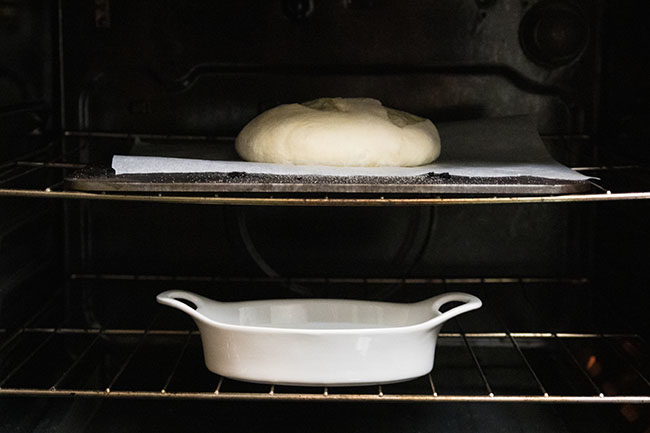
When you're ready to bake, place your bread onto the baking steel (use a piece of parchment paper to make it easier to transfer bread to the oven if you like!) and bake as directed.
Carefully remove the dish of water from the oven for the last 10-20 minutes of baking (if you're following a Dutch oven bread recipe, pull the water dish out when it tells you to remove the Dutch oven's lid!)
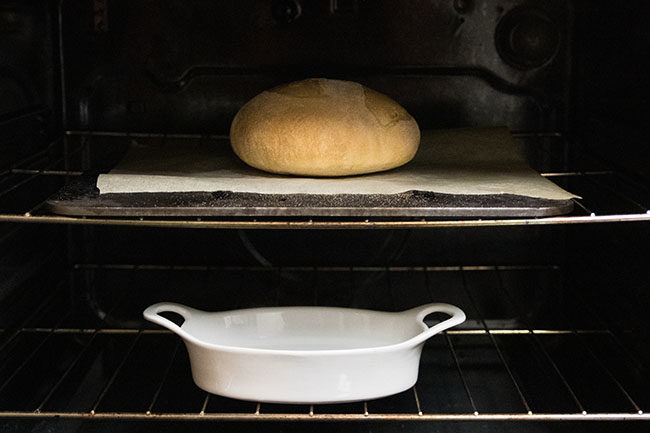
Don't worry about trying to pour off the water while it's still hot (that's a good way to burn yourself!) - just set the baking dish on the stove or a trivet and let it cool.
PS - You can totally use a cast iron skillet and ice cubes to create steam with a baking steel or stone, or use a dish of water when baking with a cast iron skillet! We just wanted to illustrate both options for you - choose the steam method you like best!
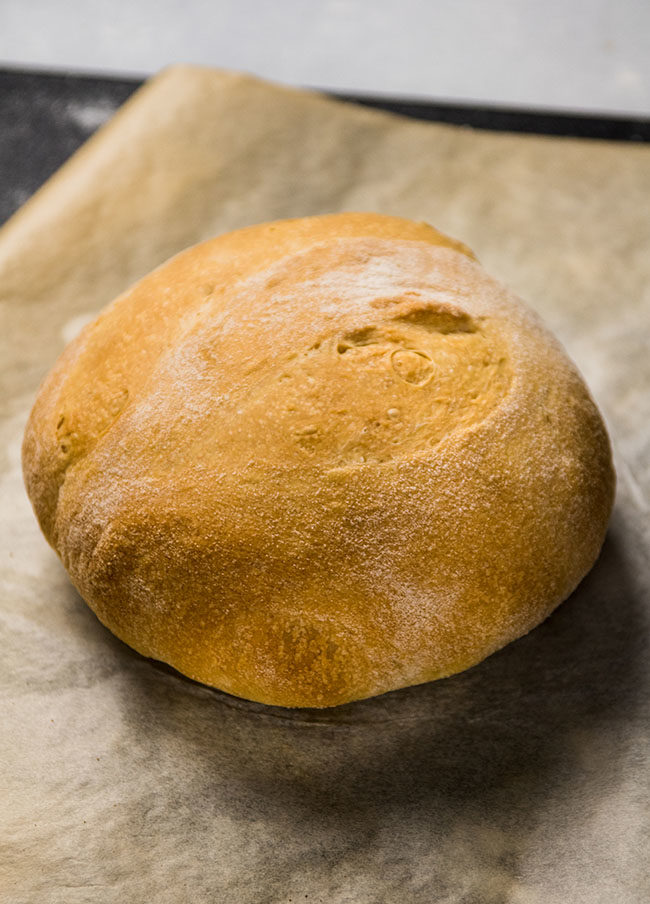
Other ways to create steam in your oven:
This isn't an end-all, be-all list of all the ways to bake crusty bread without a Dutch oven! We've also tested and generally liked the following methods (and if you have another strategy you love, be sure to drop us a comment!)
- Fill a clean spray bottle with warm water. Spray several pumps of water right into the oven or onto the bread dough right when you place the bread onto a pizza stone, baking steel, or even a preheated sheet pan, and then again after 5-10 minutes in the oven. I've baked bread this way many times, and it works in a pinch, but it's probably my least favorite method. It just doesn't quiiiiiite give you the same crispy, crunchy crust as some of these other strategies!
- Place an oven-safe mixing bowl upside-down over bread that you bake on a pizza stone or baking steel. This method does a great job of creating steam and developing a crisp crust, but it's awfully annoying to try to lift a big bowl off of a flat surface while wearing oven mitts, not to mention a lot easier to accidentally burn yourself.
- Pour water into a hot cast iron skillet right when you put your bread onto a pizza stone or baking steel. Some bakers recommend pouring very hot water into a preheated cast iron pan to create steam, and some recommend pouring COLD water into a preheated pan, either from a bowl or a long funnel. Does it work? Sure. But again: ANNOYING. I find it much easier to use one of these other methods.
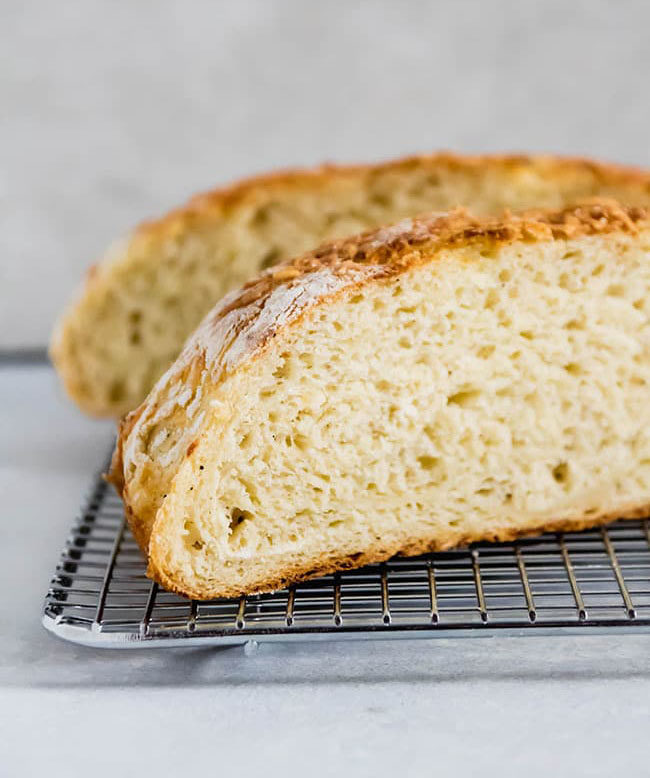
So. Do you need a Dutch Oven to make great homemade bread?
No. But if you bake bread often and can make the investment, it will certainly make the process a little bit easier. Of all the methods we've tried to make crusty bread at home, a Dutch oven is far and away our favorite.
If you're ready to pull the trigger on a Dutch oven, here are a few of our favorites:
- Lodge 6 qt. Enameled Cast Iron Dutch Oven
- Le Creuset 5 ½ qt. Enameled Cast Iron French Oven
- Marquette Castings 6 qt. Cast Iron Dutch Oven
Our favorite homemade bread recipes:
Ready to bake some bread? Check out our favorite (and most popular!) crusty bread recipes:


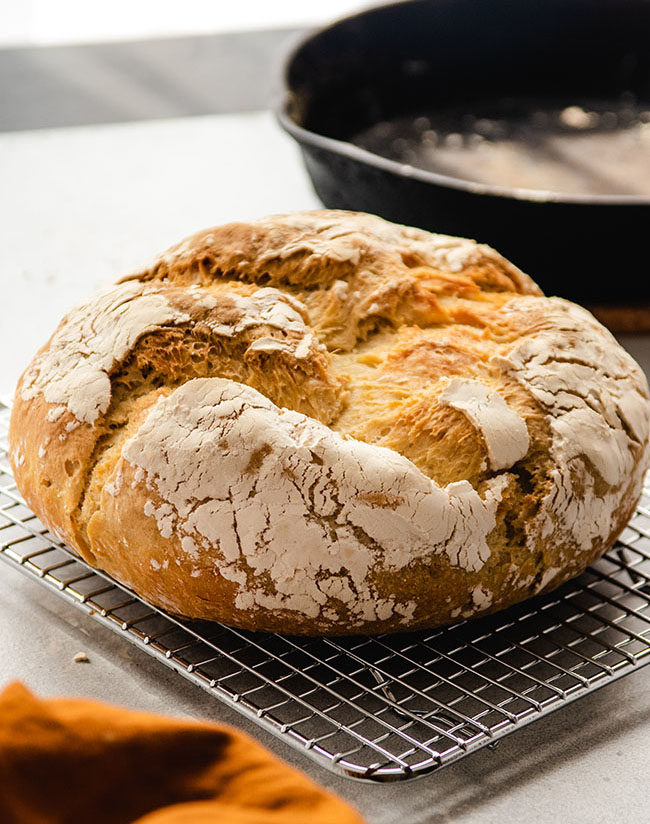
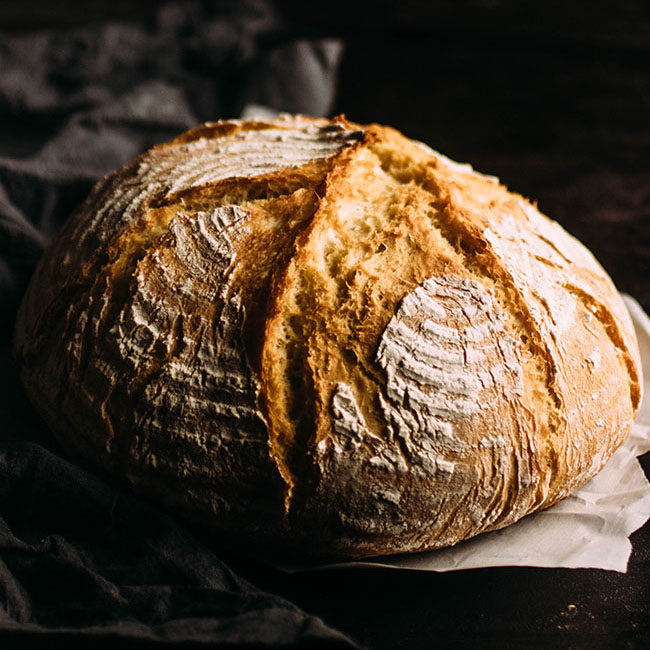
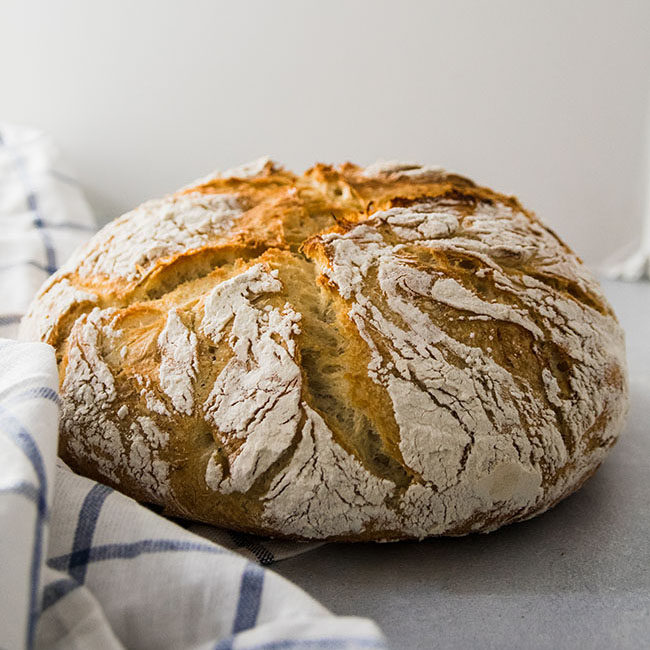
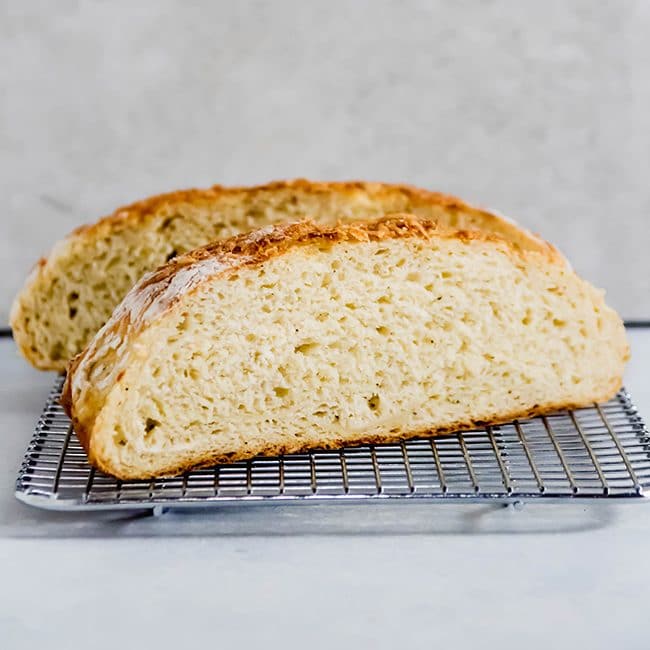
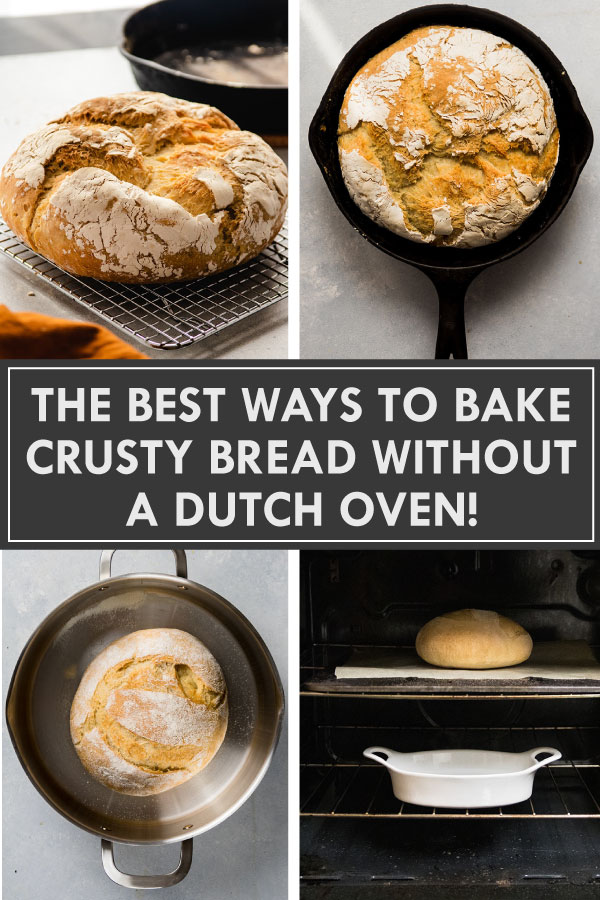
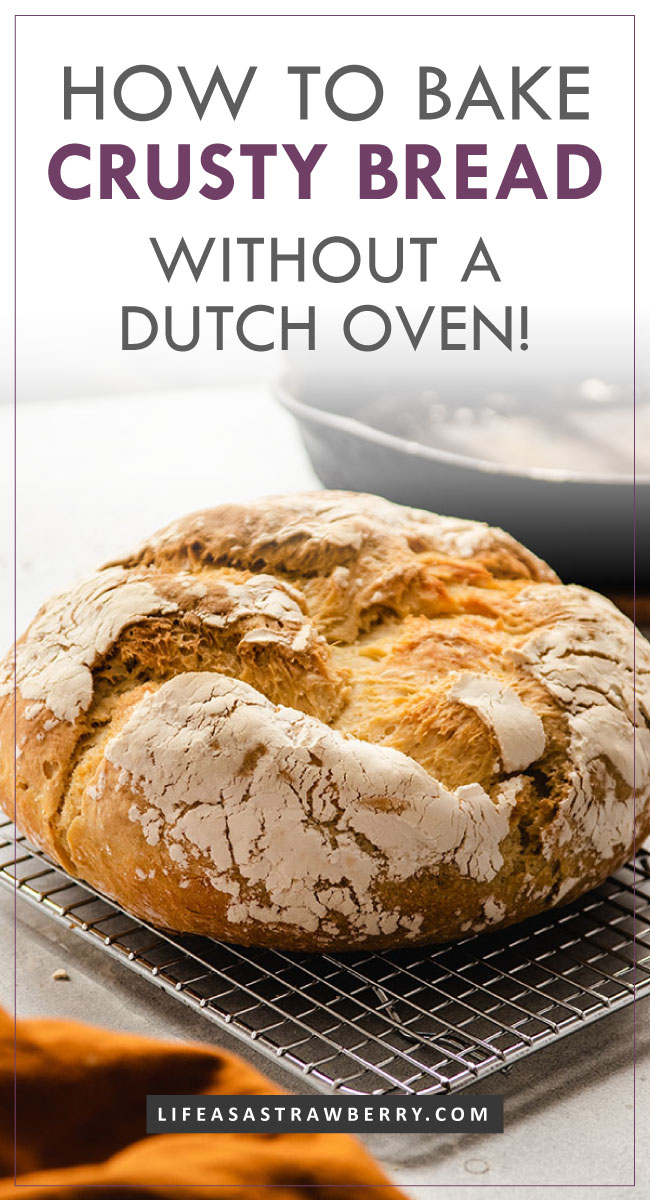
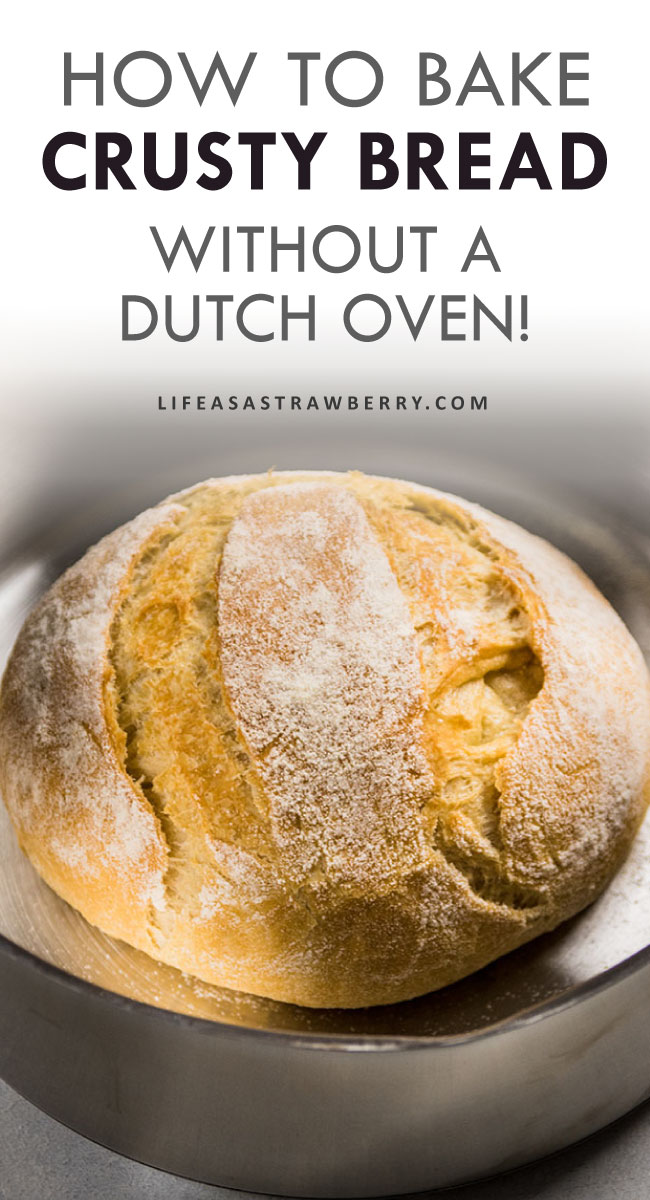
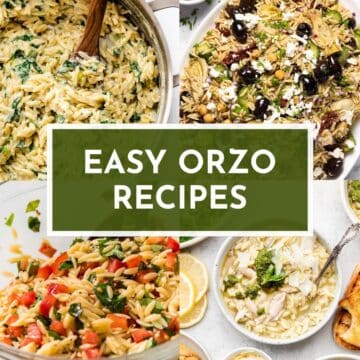
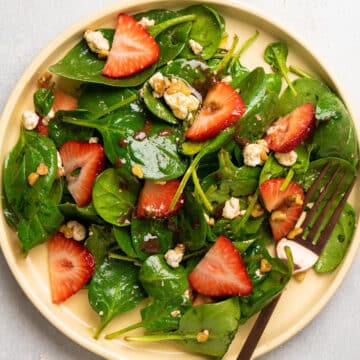
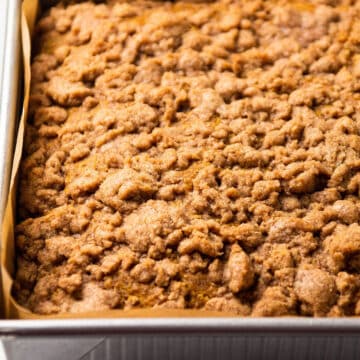

Tineke
Hi,just had my very first go at your bread recipe.
It was very sticky to the end ,even when I shaped it for a while.
Should I use more flour or maybe a stronger flour like bread flour?
It’s still in the oven , looking forward to pulling it out.
Team Life As A Strawberry
Our Easy Crusty French Bread is a relatively slack (wet) dough, so it will be a bit shaggy and sticky at first, but it should smooth out and become more elastic as it rises and again as you shape it! You can always add more flour if you need to (1/4 cup at a time) in order to get a consistency that you feel comfortable working with. The wetness of dough can also be affected by environmental factors like humidity, so if you were baking on a warm, humid day the dough may have felt wetter this time!
Oralea
This post was so helpful. I made a version of No Knead Bread and preheated my Le Cruset enameled dutch oven in the oven... but it started smoking and the outside of it turned a dark color. All before I even put the dough in! I was too scared to put it back in the oven so used a baking sheet and it came out deliciously.
Team Life As A Strawberry
We're so happy this post was helpful to find alternative ways to bake your bread!
Jake
I use a le creuset 5qt Dutch oven to bake bread I make. For fear of the enamel cracking I always coat the inside with either vegetable oil or avocado oil. Of course this results in a dark brown patina on the interior of my Dutch oven, which is extremely hard to clean off (I always end up using bar keepers friend). Do I really need put a light coating of oil to protect my Dutch ovens enamel or is there a better way to clean the enamel afterwards or should I just leave the seasoning to form a patina or should I invest in a Emile Henry bread cloche? I use my Le Creuset for a lot of things and I just want to take as best care of it as possible! Thank you.
Team Life As A Strawberry
Our team uses Le Creuset Dutch ovens for frequent bread baking (even up to 500 degrees for sourdough!) without an oil coating and haven't experienced enamel cracking, but we always want you to trust your instincts to keep your equipment in tip-top shape! We do recommend using parchment paper to keep the dough separated from the Dutch oven, which keeps the bottom of the loaf from burning, makes it easier to put the loaf in the hot Dutch oven, and keeps the Dutch oven clean!
We haven't tested the Emile Henry cloche, but we recommend Staub, Marquette Castings, and Lodge Dutch ovens if you want to add another Dutch oven to your kitchen. We also have the methods above to make crusty bread without using a Dutch oven!
patsy
I cannot heat my oven above 400 degrees. Can i bake the einkorn no-knead bread in a stainless steel "dutch oven' or in a pottery crockpot insert?
Team Life As A Strawberry
We have a full list of our favorite ways to cook crusty bread without a Dutch oven!
Lois A Jones
CAn I use a 10x5x4 inch loaf pan to make this bread with a pan of water under neath?
Team Life As A Strawberry
We haven't tested our Easy Crusty French Bread recipe in a loaf pan, but we expect it would work! You may need to adjust the cooking time and use a lower oven temperature. The steam from the pan of water underneath will be important for the crispy crust and soft inside! If you are looking for a loaf pan recipe with a soft sandwich bread texture instead, this recipe from About to Sprout is a great fit!
Windy
how about a terracotta chicken roaster?
Team Life As A Strawberry
Hi Windy! We haven't tested this recipe in a terracotta chicken roaster, but we have a whole list of our recommended substitutes for a Dutch oven!
Elba
thank you. I was worrying about not buying expensive bowls and baking stones. Now I think I can use my stainless steel dutch oven happilyl
Team Life As A Strawberry
YAY! Happy bread baking!
Bella mangepano
What temperature does the oven have to be at with the one with the pot and pan?
Team Life As A Strawberry
Hi Bella! The oven temperature will depend on the recipe you're following. Our Easy Crusty French Bread recipe uses an oven temperature of 460 degrees!
Diane
great tips. inspired to try. Thank you
Team Life As A Strawberry
Thanks so much, Diane! Happy bread-baking!
Lisa
Hello, my dutch oven is cast aluminum, not cast iron. Will my cast aluminum dutch oven work? Thank you.
Team Life As A Strawberry
Hi Lisa! We haven’t tested this recipe in a cast-aluminum Dutch oven, but we expect it to work similarly to cast iron. Aluminum may not hold onto heat as well which could impact your baking time, so there may be a little trial and error involved. We also have a full breakdown of our recommended cooking methods if you don’t have a Dutch oven in this post!
Andrea
Thanks for this! I just made my first ever yeast bread (using your Easy Crusty French Bread recipe) using a a cast iron pan with a baking dish of water on the shelf below, and it turned out great! I would have given up a dozen times if it wasn’t for all your tips. Thanks so much!
Team Life As A Strawberry
WAHOO! Way to go, Andrea!
CX
Hi there, I used option 2 this Sunday afternoon and if worked perfect ! My baking sheet was uneven (maybe) so if wasn't laying totally flat on the top of my pot, so I added another baking sheet as weight.
Used 1 cup whole wheat flour and 2 cups all-purpose flour. I found that it was really dry, so I added more warm water. I may have packed the flour in my measuring cup too much...
Anyway, it worked out well 🙂 thank you. The family enjoyed it.
Team Life As A Strawberry
We're so happy you enjoyed it! Measuring flour can be really tricky, we definitely recommend a scale if you'll be baking often!
Serah
I'm curious about the cast iron skillet option. I don't have two, so I'd plan to use the one I have for the bread itself, but for the steaming pan would it work to just use a sheet pan for the ice cubes?
Team Life As A Strawberry
Hi Serah! Yes, you can use a thick metal baking dish or sheet pan for the ice cubes! Just be sure to avoid using glass or ceramic because the temperature change can cause those materials to break.
Julie W
Well Jessie, I sure wish you'd elaborated on "Some bakers recommend pouring very hot water into a preheated pan to create steam, and some recommend pouring COLD water into a preheated pan, either from a bowl or a long funnel."
I used room temp water in the hot glass pan and it exploded in my oven. I'm glad the baking stone was above it and I wasn't impaled by the glass chards. I wish I could upload a picture of the mess that was made. I hope you revise your article with very clear instructions. Perhaps don't recommend a glass dish. Ugh.
Jeff
You mis-read the instructions. Option 3 using a glass dish says to place water into dish and then into oven. The dish is not pre-heated. If you look at the end of option 1 which talks about preheating, it says not to use ceramic or glass.
Team Life As A Strawberry
Hi Julie! We know how scary and frustrating it can be when equipment breaks in the kitchen! The instructions you're referencing are from the section on using a cast iron pan to create steam. As we mention in the post, we do not recommend using glass cookware because it can shatter when it experiences extreme temperature changes.
Sherri
I was wondering if you could cut the proofed dough in 1/2 and bake in 2 smaller cast iron Dutch ovens. Would the bake time be the same? Great recipe but there’s just 2 of us so I thought I could gift the other 1 lol
Team Life As A Strawberry
Hi Sherri! Totally! Smaller size Dutch ovens work great. You would just shape and have the final rise after the dough is cut in two. Cut the bake time to 18 min with the lid and 5-10 minutes without (as needed). If you would prefer to bake a whole loaf, check out our post How to Make Crusty Bread Without a Dutch Oven to find other alternatives you already have in your kitchen.
Connie
Can’t wait to try, I have a 4qt oval roaster, you know the ole darK blue and white speckled with a lid , think that would work instead of a Dutch oven. Thank you
Team Life As A Strawberry
Hi Connie! We don't recommend using a roasting pan, but you're in luck! We have a whole post about alternatives to using a Dutch oven, check it out here!